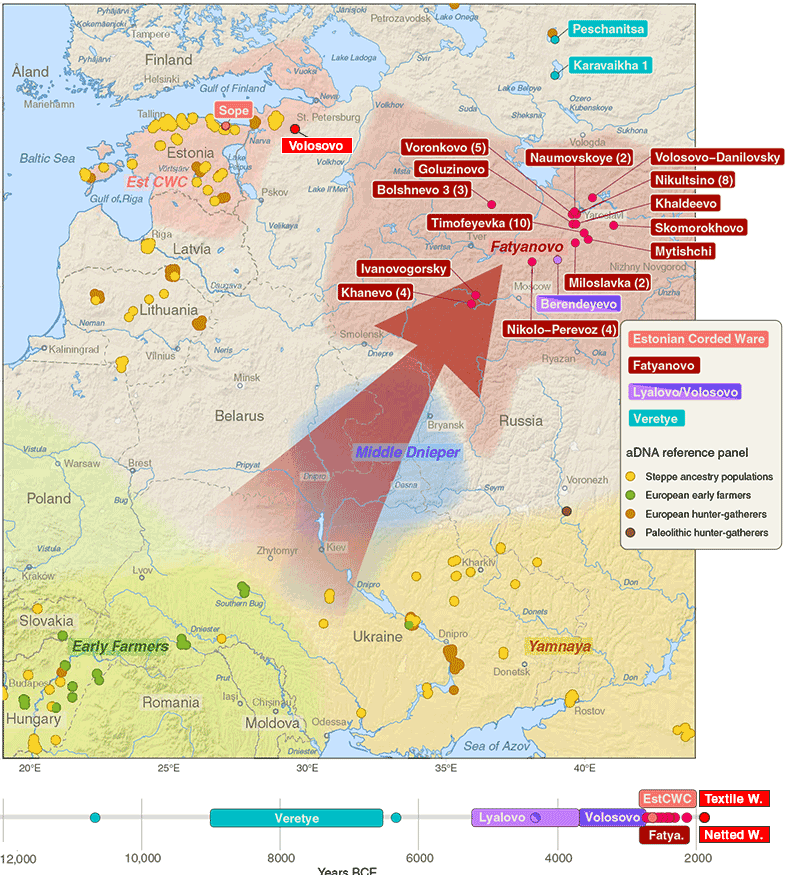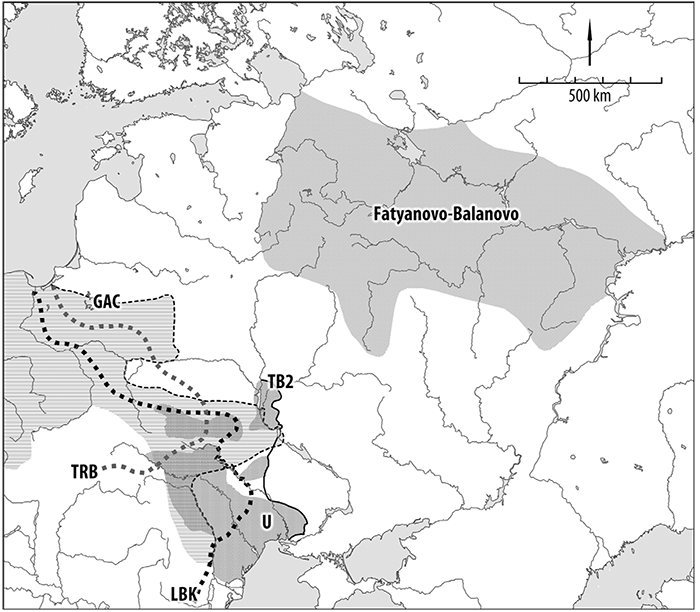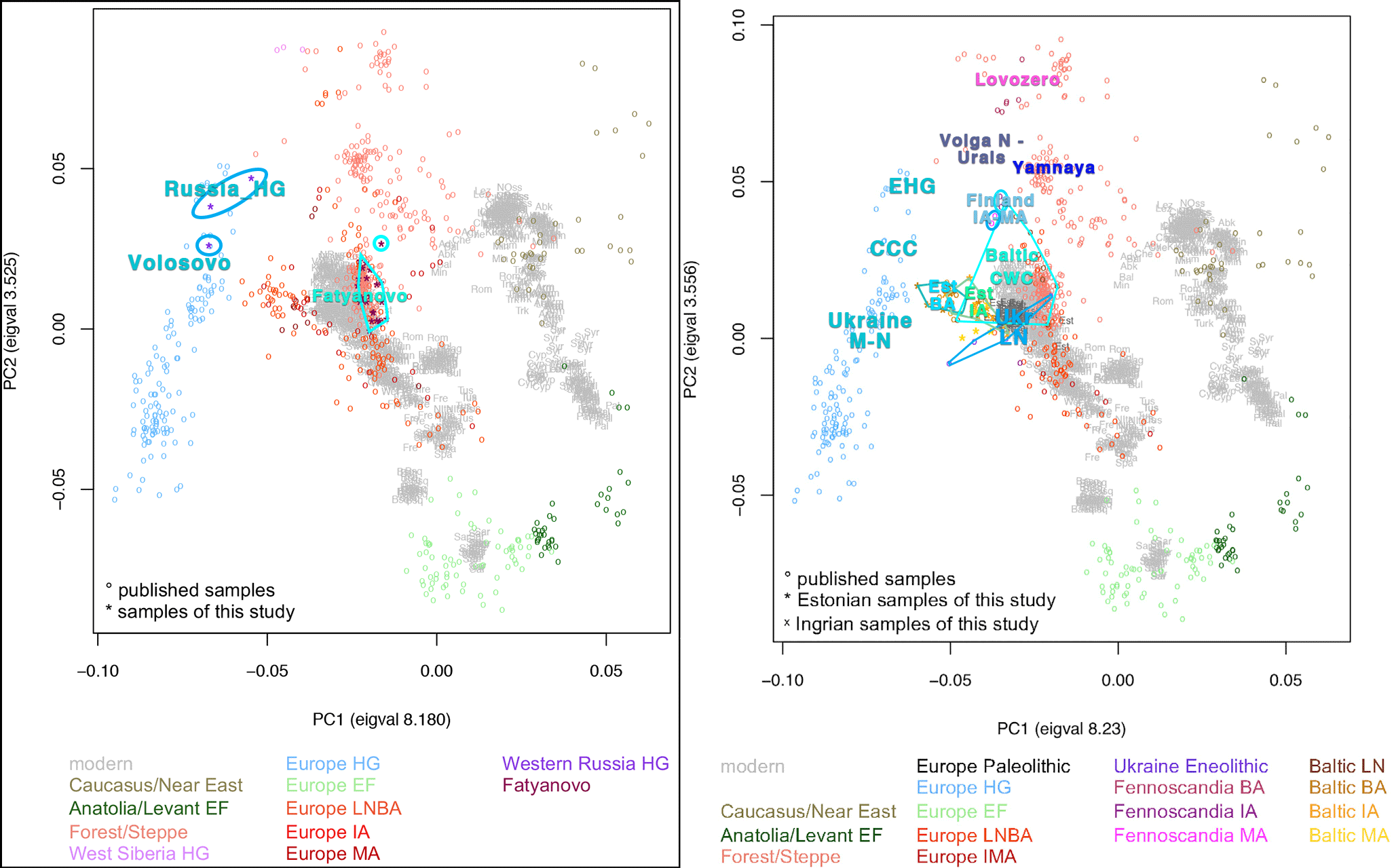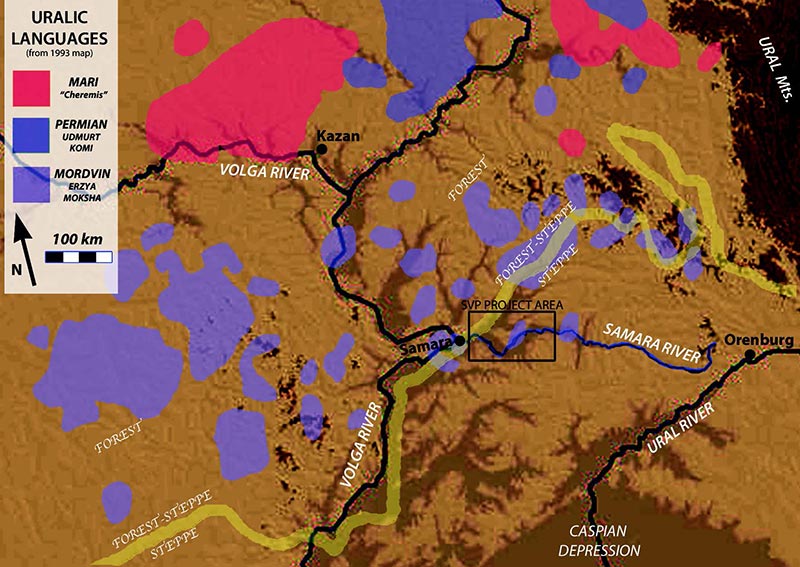The recent preprint on ancient DNA from Veretye, Lyalovo/Volosovo and Fatyanovo from Saag et al. (2020) has been published in Science Advances Vol. 7, no. 4, eabd6535, and with it the BAM files.
Here are the Y-SNP calls from the files, following the FTDNA Haplotree standard, with Fatyanovo individuals in alphabetical order:
- Veretye PES001 from Peschanitsa (ca. 10785–10626 calBC), mtDNA U4a1, Y-DNA R1a>M459>YP1301(>pre-YP1272?), with 2 SNPs derived – YP1306 (T->C, 5 reads) and Y12474 (T->A, 6 reads) – and 46 SNPs ancestral at the YP1272 level. A sample with 5× coverage that provides evidence for EHG ancestry in northwestern Russia close to the time it was populated.
- Volosovo/Lyalovo BER001 from Berendeyevo (ca. 4447–4259 calBC), mtDNA K1+16362, Y-DNA Q>MEH2>M346>L53>L54(>CTS3814>CTS11969>pre-L804), with 6 derived and 4 ancestral SNPs at the L804 level, without intermediate SNPs with L54. [#EDIT: The pre-L804 position has been confirmed by Göran Runfeldt from FTDNA, which suggests that it will split this European branch]
- Fatyanovo BOL001 from Bolshnevo 3 (ca. 2829–2460 calBC), mtDNA H1b, Y-DNA R1a>M459>M198>M417, with multiple negative SNPs below (but limited coverage).
- Fatyanovo BOL003 from Bolshnevo 3 (ca. 2571–2345 calBC), mtDNA H41a, Y-DNA R1a>M459>M198>M417>PF6162>Z93(*?): xZ94; xBY226207; xYP5585>YP5582; xFGC82884>FGC45861>FT115524, xFGC82884>KMS149, xFGC82884>KMS149>FT18317, xFGC82884>FT69724>YP1506, xFGC82884>FT69724>Y39884>Y41571,…,xFGC82884>YP5321, etc.
- Fatyanovo GOL001 from Goluzinovo (ca. 2575–2349 calBC), mtDNA T2b, Y-DNA R1a>M459>M198>M417(*?): xPF6162 (CTS12179, C->T, 1 read); xCTS4385>FGC9988, and all covered SNPs below xCTS4385>Y2894>L664. The only clear R1a-M417(xZ645) in the dataset.
- Fatyanovo HAL001 from Khaldeevo (ca. 2832–2473 calBC), mtDNA N1a1a1a2, Y-DNA R1a>M459>M198>M417>PF6162>Z93(*?): xZ94; xYP5585>YP5582; xFGC82884>FGC45861>FT115524, xFGC82884>KMS149, xFGC82884>FT18317, xFGC82884>FT369724>BY30940, etc.
- Fatyanovo HAN002 from Khanevo (ca. 2859–2495 calBC), mtDNA U5a1a1, Y-DNA R1a>M459>M198>M417>PF6162>Z93(*?): xZ94>Z2124, xZ94>FT19753>F2497, xZ94>FT19753>Y40>FT129490, xZ94>FT19753>Y37, etc.; xYP5585>YP5582; xFGC82884>FGC45861>FT115524, xFGC82884>KMS149>KMS133, xFGC82884>KMS149>Y20793, xFGC82884>FT18317, xFGC82884>FT369724>BY30940, etc.
- Fatyanovo HAN004 from Khanevo (ca. 2835–2471 calBC), mtDNA H6a1a, Y-DNA R1a>M459>M198>M417>PF6162>Z93(*?): xZ94; xYP5585>YP5582; xFGC82884>FGC45861>FT115524, xFGC82884>KMS149, xFGC82884>FT18317, xFGC82884>FT369724>BY30940, xFGC82884>FT369724>YP1506, xFGC82884>Y39884, xFGC82884>YP5321.
- Fatyanovo NAU001 from Naumovskoye (ca. 2836–2573 calBC), mtDNA T2a1b1a, Y-DNA R1a>M459>M198>M417>PF6162>Z93(*?): xZ94; xYP5585; xFGC82884>FGC45861>FT115524, xFGC82884>KMS149, xFGC82884>FT18317, xFGC82884>FT369724>BY30940, xFGC82884>FT369724>YP1506, xFGC82884>Y39884.
- Fatyanovo NAU002 from Naumovskoye (ca. 2836–2469 calBC), mtDNA U5b2a1a2, Y-DNA R1a>M459>M198>M417>PF6162>Z93(*?): xZ94; xBY226207; xYP5585, xFGC82884>FGC45861>FT115524, xFGC82884>KMS149, xFGC82884>FT18317, xFGC82884>FT369724>YP1506, xFGC82884>Y39884, xFGC82884>YP5321.
- Fatyanovo NIK002 from Nikultsino (ca. 2865–2500 calBC), mtDNA U5a1a1, Y-DNA R1a>M459>M198>M417>PF6162, with multiple negative SNPs below (but limited coverage).
- Fatyanovo NIK003 from Nikultsino (ca. 2522–2298 calBC), mtDNA H15a1, Y-DNA R1a>M459>M198>M417, with multiple negative SNPs below (but limited coverage).
- Fatyanovo NIK006 from Nikultsino (no date), mtDNA W1c, Y-DNA R1a>M459>M198>M417, with some negative SNPs below (but very limited coverage).
- Fatyanovo NIK008 from Nikultsino (ca. 2834–2472 calBC), mtDNA H5b, Y-DNA R1a>M459>M198>M417>PF6162>Z93(*?): xZ94; xBY226207; xYP5585; xFGC82884>FGC45861>FT115524, xFGC82884>KMS149>FT18317>Y34305, xFGC82884>KMS149>FT18317>YP1451>BY62671, …, xFGC82884>Y39884, xFGC82884>YP5321, xFGC82884>KMS149>KMS133>BY55950, etc.
- Fatyanovo TIM001 from Timofeyevka (no date), mtDNA K1b1a1+199, Y-DNA R1a>M459>M198>M417, with some negative SNPs below (but very limited coverage).
- Fatyanovo TIM008 from Timofeyevka (no date), mtDNA K1c1, Y-DNA R1a>M459>M198>M417>PF6162, with some negative SNPs below (but very limited coverage).
- Fatyanovo VOR002 from Voronkovo (no date), mtDNA H2a1, Y-DNA R1a>M459>M198, with some negative SNPs below (but very limited coverage).
- Fatyanovo VOR001 from Volosovo-Danilovsky (2570–2299 calBC), mtDNA J1c1b1a, Y-DNA R>M173 (M812, T-C, 1 read), negative for R1a equivalent CTS9667 (A->G, 1 read), unreliable (very limited coverage).
- Fatyanovo VOR003 from Voronkovo (2573–2466 calBC), mtDNA H6a1a, Y-DNA R1a>M459>M198>M417>PF6162, with some negative SNPs below (but very limited coverage).
- Fatyanovo VOR005 from Voronkovo (2840–2343 calBC), mtDNA K2a5b, Y-DNA R1a>M459>M198>M417>PF6162, with some negative SNPs below (but very limited coverage).
Another relevant sample is found in the recent Harney et al. (2020):
- Late Fatyanovo/Ingria BA I20762_120784 from Volosovo (ca. 2050–50 BC), of hg. R1a>M459>M198>M417>PF6162>Z93(*?): xZ94; xFGC82884>FGC45861>FT115524, xFGC82884>KMS149>KMS133, xFGC82884>FT18317>YP1451, xYP5585>YP5582, etc.

Fatyanovo-Balanovo
Interesting excerpts from the recent paper (behind paywall) The Forgotten Child of the Wider Corded Ware Family: Russian Fatyanovo Culture in Context, by Heyd & Nordqvist Proceedings of the Prehistoric Society (2020):
[The Fatyanovo and Balanovo Cultures] share many similar features in material culture but regional differences exist in, for example, certain aspects of burial customs, settlement sites, and metal production (Bader 1963, 315; Kraynov 1972, 11).
Geography
The area of the Fatyanovo Culture stretches from the upper reaches of the Dnepr and Desna Rivers and Lake Peipus to the Mari El and Chuvash Republics on the Middle-Volga, whereas Balanovo extends all the way to the Vyatka–Kama interfluve. The distribution area is located in the zone of deciduous or mixed forests, with sites and finds following the major river valleys and watersheds, even if individual discoveries have been made further away in the surrounding territories.
Chronology
The beginnings of Fatyanovo – as of CWC in many other areas – date to the period marked by a plateau in the calibration curve (c. 2900–2600 cal BC). Thus, based on current knowledge, we cannot directly pinpoint the earliest occurrence, although the datings imply that the development of Fatyanovo was not significantly later than the CWC further west.

Burials
Cemeteries and burials are situated on high ground, on hilltops and high slopes, along waterways, wetlands and on watersheds.
Similar to the eastern Baltic and Finnish CWC groups, barrows are not often identified among the Fatyanovo antiquities. Apart from a few possible examples in the Moscow-Klyazma region (Kraynov 1972, 26; Gadzyatskaya 1976, 73), kurgans are known only in the Balanovo area (Bader & Khalikov 1987, 78–9; Solovev 2016, 63–4). Fatyanovo burials are flat earth graves.
Grave orientation is predominately west–east or south-west–north-east, but regional variation is large and north-west–south-east and north–south orientations are known. Commonly, females are lying on the left side with the head pointing eastwards, while males are on the right side, the head towards westerly directions (Kraynov 1972, 189–91; Kraynov & Gadzyatskaya 1987, 11–13).
Grave goods are almost always present.(…) A stone battle axe is present in most male burials, rarely in female or juvenile graves. Many deceased have been buried with a wedge-shaped flint work axe and pottery vessels are encountered in nearly all graves. Other grave goods include flint knives (both sexes), occasional whetstones (male), bone and antler tools (daggers, knives, adzes, awls, points, spatulas, pins – male; awls, needles – female), adornments (bone, tooth, shell, amber – predominately female), as well as small flint tools (blades, scrapers, points, burins), and debitage and animal bones (remains of meals?) (Kraynov 1972, 193–8; 1987, 65). Metal is rare. As a special case, a couple of burials with utensils for metal production (hence the name ‘founder’s grave’) can be mentioned from Fatyanovo-Balanovo contexts (Kraynov 1972, 168–9; Chernykh 1992, 135).
Metal objects
Despite earlier occurrences of simple copper items in the forest zone (Nordqvist et al. 2012, 15–16), the CWC horizon represents the wider spread of metal artefacts in the area. The origins of metalwork have been sought between the Caucasus and eastern Europe (Gorodtsov 1916, 147–8; Äyräpää 1933, 153; Krivtsova Grakova 1947, 32), and currently associated with the Circumpontic areas and the Carpathian region (Chernykh 1992, 136). The focus of metallurgy was in the east, in the Middle-Volga region and the Balanovo territory, where raw material was procured from copper-bearing sandstones of the Kama River valley and the western Ural Mountains. Metal finds are relatively few in the west, especially in the Moscow-Klyazma area (Krivtsova-Grakova 1947, 32; Kraynov 1972, 156).

Subsistence economy
Domestic animals (excluding dog) are not known in the earlier materials from the area, but their existence in Fatyanovo contexts is testified by bones and teeth of several species. Pig and sheep/goat are considered significant from the beginning and cattle and horse are later supplements, in addition to which dog was present (Kraynov 1972, 137; 1987, 65–6; also Bader & Khalikov 1987, 80).
Factual evidence of farming is even more limited. The practice of simple slash-and-burn cultivation is proposed (Bader 1937, 29; Kraynov 1972, 146), but its role is not considered crucial.
Exploitation of wild resources is testified by the remains of both meatand fur-bearing animals like elk, wild boar, brown bear, reindeer, roe deer, beaver, marten, fox, lynx, otter, birds, and fish, as well as shells and nutshells (Kraynov 1987, 66; also Bader & Khalikov 1987, 81).
Society
Cemeteries are supposed to be associated with family-based blood-kin groups who, together with other similar and related groups, formed larger tribes and alliances (Kraynov 1972, 203; Volkova 2014, 41; also Bader & Khalikov 1987, 81), (…) The society is stereotypically described as chief- and male-oriented due to the presence of some richly furnished male burials (Kraynov 1972, 203–4; Volkova 2014, 41), occasionally accompanied by individuals interpreted as sacrificed household members or wives (Kraynov 1972, 192)
Animal and especially bear cult is suggested because of the few bear burials and bear tooth pendants in graves (Kraynov 1972, 199; 1987, 71), and the cult of ancestors is also assumed, but not elaborated further (Kraynov 1941, 135).
Comments
To fully understand the relevance for ethnolinguistic purposes of the material culture of Baltic Corded Ware and Fatyanovo groups, which did not fully develop the so-called Steppe package, one needs to consider first what features stand out from Yamnaya to be considered the paradigmatic Indo-European-speaking culture. Once this is understood, it goes without saying that the material culture of Eastern Corded Ware groups is more similar to what is expected from a Proto-Uralic community and its early offshoots.
NOTE. For more on this, see the whole series on Palaeolinguistics and the Proto-Uralic Homeland.

[I am still to review some samples, so this text below might change]
1. The first noticeable aspect of Fatyanovo patrilineages is that most subclades suggest that the deepest among them are basal Z93, in common with the Late Trypillian and Babyno samples, and in line with the expected recent bottleneck of R1a-Z645 to the south-west. This is also consistent with the subsequent bottlenecks of Abashevo-related lineages that spread (through the Seima-Turbino phenomenon) with the Andronovo-like horizon and (through Sintashta-Potapovka) into the Srubnaya-Andronovo horizon.
NOTE. This is yet another indirect proof that the Alexandria sample is unlikely to be of hg. Y3 and – supposedly – 1,500 years older, most likely belonging to Middle Dnieper or Srubnaya instead.
2. Also relevant is the lack of hg. R1a-Z280, a haplogroup likely prevalent among ancient Uralic peoples, and shared by modern Finno-Ugrians on both sides of the Urals (including Hungarians), and also found in ancient DNA beyond the Eastern Baltic in Srubnaya (as basal clades), in Mezhovskaya, and later in Asia among the Xiongnu.
Both points suggest that Fatyanovo (or at least its western part) was an isolated Corded Ware offshoot parallel to Abashevo, rather than its origin, since “non-basal” R1a-Z93 as well as R1a-Z280 are expected to be found among Pre-Ugric and Pre-Proto-Samoyedic speakers expanding east. On the other hand, the origin of East Uralic peoples must be close enough to the source of Z93 expansions, because Z93(xZ94) is particularly prevalent today around the Altai – in the region reached by the Andronovo-like Horizon and that formed later part of acculturated “Micro-Altaic”-speaking populations – but they are also still found among Mari and Udmurts, and are likely to keep popping up in North-Eastern Europe from the Bronze Age until the Middle Ages.

Related
- R1a-Z93-rich Classical CWC-like Fatyanovo replaced Volosovo
- Fully Steppe-like Proto-Corded Ware Late Trypillians
- R1a-Z280 and R1a-Z93 shared by ancient Finno-Ugric populations; N1c-Tat expanded with Micro-Altaic
- R1b-rich Proto-Indo-Europeans show genetic continuity in Asia
- Earliest R1a-Z93…from Late Trypillia in the Podolian-Volhynian Upland!
- Volosovo hunter-gatherers started to disappear earlier than previously believed
- “Steppe ancestry” step by step (2019): Mesolithic to Early Bronze Age Eurasia
- On the Ukraine Eneolithic outlier I6561 from Alexandria
- Genetic continuity among Uralic-speaking cultures in north-eastern Europe
- Baltic Finns in the Bronze Age, of hg. R1a-Z283 and Corded Ware ancestry
- Early Uralic – Indo-European contacts within Europe
- Corded Ware ancestry in North Eurasia and the Uralic expansion
- Uralic speakers formed clines of Corded Ware ancestry with WHG:ANE populations